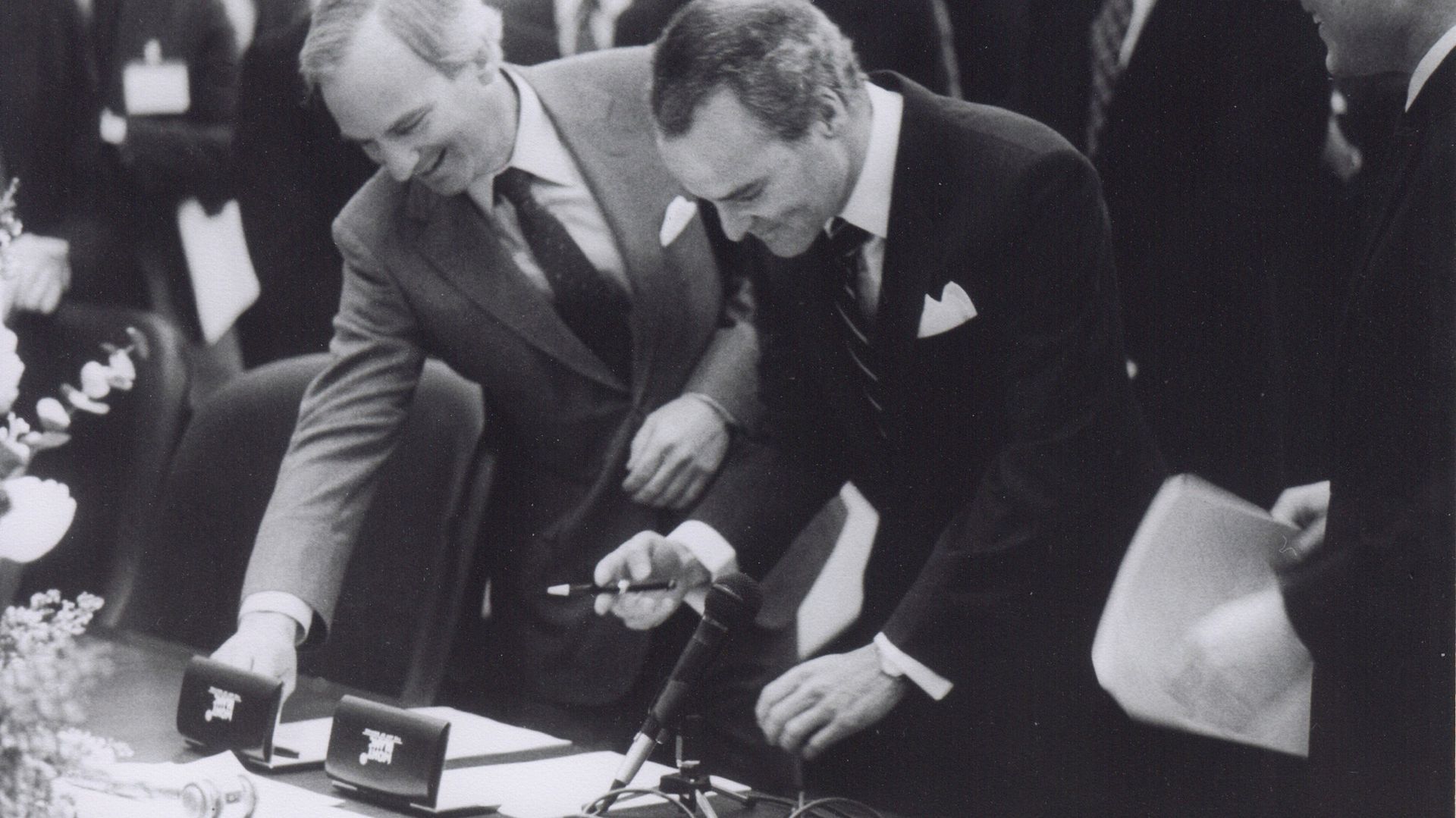尊敬的用戶您好,這是來自FT中文網的溫馨提示:如您對更多FT中文網的內容感興趣,請在蘋果應用商店或谷歌應用市場搜尋「FT中文網」,下載FT中文網的官方應用。


Consider the tale of two $20bn-something companies — both of them private equity buyouts.
想想兩家200億美元左右的公司的故事——都是私募股權收購。
Thirty-five years ago, when Kohlberg Kravis Roberts pounced on the food-to-tobacco conglomerate, RJR Nabisco, the private equity industry hit mainstream headlines for probably the first time. The scale of that $25bn Nabisco deal — immortalised in the bestselling business book Barbarians at the Gate — is still totemic. (It dwarfs last year’s biggest global buyout — the $14bn paid for Toshiba by Japan Industrial Partners).
35年前,科爾伯格-克拉維斯-羅伯茲集團(KKR)收購了業務涵蓋食品菸草的企業集團雷諾茲-納貝斯克(RJR Nabisco),私募股權投資行業可能是在此時第一次登上主串流媒體的頭條。250億美元的納貝斯克交易的規模至今仍有圖騰意義——該協議被商業暢銷書《門口的野蠻人》(Barbarians at the Gate)載入史冊。(它使去年最大的全球收購案——日本產業合作伙伴公司(JIP)爲東芝(Toshiba)支付140億美元——相形見絀)。
But in most other respects, private equity has been transformed over the past three decades. In 1989, it was still essentially a cottage industry — aggregate annual deal volumes from the 1980s until the end of the century rarely topped 1 per cent of GDP, even in the US, according to the OECD. Over the past four years, that ratio has ranged between 2 and 5 per cent, PitchBook data suggests. The intervening period witnessed vast leverage-fuelled expansion underpinned by an unprecedented era of ultra-low interest rates.
但過去三十年間,私募股權投資在大多數其他方面發生了巨大變化。1989年,私募股權投資基本上還是家庭作坊產業——根據經合組織(OECD)的數據,從1980年代到上世紀末,即使在美國,每年的總交易量也很少超過國內生產總值(GDP)的1%。PitchBook的數據顯示,在過去四年裏,這一比例在2%到5%之間。期間,在前所未有的超低利率時代的支撐下,該行業出現了大規模的槓桿擴張。
Few deals were more aggressive than KKR-Nabisco. But the most famous buyout in history soon became the most infamous. Over a 15-year period, as tobacco risks mounted and debt costs ballooned, the original deal rationale broke down. Ultimately KKR lost $730mn on the transaction.
很少有交易比KKR-納貝斯克更激進。但歷史上最著名的收購很快就變成了最臭名昭著的收購。在長達15年的時間裏,隨著菸草風險的增加和債務成本的膨脹,最初的交易原理崩潰了。最終,KKR在這筆交易中損失了7.3億美元。
Plenty of other companies have been ransacked over the years, often highly successfully for their private equity owners. But the industry today cannot be caricatured homogeneously as short-termist, debt-addicted asset-strippers.
多年來,還有許多其他公司被洗劫一空,往往讓私募股權所有者獲得巨大成功。但是,今天的行業不能被簡單地描述爲短期主義者、負債累累的資產掠奪者。
Take the case of Visma, another $20bn company owned by private equity. First taken private by London-based HG, with an enterprise value of about $500mn in 2006, the Nordic software business is now reckoned to be worth 40 times that — and is still majority owned by HG. The 18-year recent history of Visma’s ownership is also, in exaggerated form, the story of private equity’s broader evolution — and in multiple ways.
以Visma公司爲例,這是另一家由私募股權投資公司擁有的價值200億美元的公司。這家北歐軟體企業最初於2006年被總部位於倫敦的HG公司私有化,當時的企業價值約爲5億美元,現在的價值估計是當時的40倍,而且仍由HG公司持有多數股權。Visma公司最近18年的所有權歷史,也以誇張的形式,從多個方面講述了私募股權投資的廣泛演變。
One trend it reflects is longer hold times. In the 1990s or 2000s, a typical private equity firm would have been in and out of a deal in three or four years. Last year, the median hold time for the 1,121 companies that were sold was 6.4 years, an all-time record, according to PitchBook. This is due in part to a maturing model that goes beyond adding debt and cutting jobs. But it is also driven by private equity’s use and abuse of so-called continuation funds to extend investment horizons — either because they want to hold on to thriving portfolio companies for longer, or because they don’t want to crystallise weak valuations of underperformers.
它反映的一個趨勢是持有時間延長。在1990年代或2000年代,一般的私募股權投資公司會在三四年內完成交易。根據PitchBook的數據,去年出售的1121家公司的中位持有時間爲6.4年,創下歷史紀錄。這在一定程度上是由於公司模式日趨成熟,而不僅僅是增加債務和裁員。但這也是私募股權利用和濫用所謂的延續基金來延長投資期限的結果——這可能是因爲他們想更長時間地持有茁壯成長的投資組合公司,也可能是因爲他們不想將業績不佳公司的疲軟估值固化下來。
Selling these days is tricky — particularly into public markets that are no longer receptive to listings of highly leveraged companies with inflated private valuations. Even in the voguish technology sector, the few examples of initial public offerings by private equity-owned companies have been cautionary. (Instacart in the US is down 25 per cent since last year’s float, and Deezer in Europe is down nearly 60 per cent.) Private equity exits via IPOs, once the norm, accounted for barely 1 per cent of exits in the US and Europe last year, the PitchBook data shows.
如今,出售是一件棘手的事情,尤其是在公開市場上,因爲這些市場不再接受私人估值虛高的高槓杆公司上市。即使是在風光無限的科技領域,私募股權公司控股的企業進行首次公開發行(IPO)的少數例子也令人警惕。(美國的Instacart自去年上市以來下跌了25%,歐洲的Deezer下跌了近60%)。PitchBook的數據顯示,私募股權透過首次公開發行退出曾經是常態,但去年在美國和歐洲僅有1%。
A second trend that HG’s ownership of Visma illustrates is the shift towards multiple investors. Collaboration between private equity firms has been an on-and-off feature of the sector for decades, notably via so-called club-deals when firms pool resources in an effort to take ever bigger targets private.
HG控股Visma說明的第二個趨勢是向多投資者轉變。幾十年來,私募股權投資公司之間的合作一直是該行業時有時無的特點,特別是透過所謂的俱樂部交易,即公司集中資源,努力將更大的目標私有化。
But a new style of joint investment has also been growing, exemplified most obviously by HG. In the case of Visma, the firm has brought in a new roster of investors every three or four years — either fellow private equity firms, or their end-investor “limited partners” directly. The Norwegian group now has more than 30 investors. PitchBook data shows that deals over the past four years, involving six or more investors, have multiplied 162 per cent compared with the prior four-year period, while standard single-investor deal volumes are up only 28 per cent.
但一種新的聯合投資方式也在發展壯大,HG就是最明顯的例子。以Visma公司爲例,該公司每隔三四年就會引入一批新的投資者——要麼是其他私募股權投資公司,要麼直接是其最終投資者的「有限合夥人」。這家挪威集團目前擁有30多家投資者。PitchBook的數據顯示,過去四年中,涉及六位或六位以上投資者的交易量比前四年翻了162%,而標準的單一投資者交易量只成長了28%。
Of course every investor needs an exit at some point. Recognising that short-term IPOs might not be realistic, stock exchanges from Nasdaq to the London Stock Exchange are innovating with platforms that will make it easier for investors in private companies to auction their holdings. The LSE’s “intermittent trading venue”, which is already wooing the likes of HG and Visma, may be one forward-thinking way to begin offsetting the string of delistings it has suffered of late.
當然,每個投資者都需要在某些時候退出。由於認識到短期IPO可能不太現實,從那斯達克到倫敦證券交易所都在創新平臺,使私人公司的投資者更容易拍賣所持股份。倫敦證券交易所的「間歇性交易場所」已經吸引了像HG和Visma這樣的公司,它可能是一種具有前瞻性的方式,可以開始抵消它最近遭遇的一系列退市。
patrick.jenkins@ft.com
patrick.jenkins@ft.com